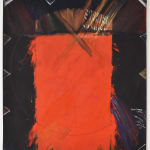





Ralph Hotere
Sunrise Mururoa / Dawn / Water Poem (After Manhire), 1985
acrylic on canvas
2040 x 1800mm
Further images
Ralph Hotere’s Dawn/Water Poem is a striking reflection on New Zealand's stance against nuclear testing in the South Pacific, resonating with the global anti-nuclear movement of the 1980s. This artwork...
Ralph Hotere’s Dawn/Water Poem is a striking reflection on New Zealand's stance against nuclear testing in the South Pacific, resonating with the global anti-nuclear movement of the 1980s. This artwork serves as a vivid protest against the French nuclear tests conducted at Mururoa Atoll, a site that became a symbol of environmental and political conflict.
Inspired by Bill Manhire’s concrete poem “Dawn/Water” from 1978, Hotere transforms the original work’s visual simplicity into a potent statement of resistance. Manhire’s poem, arranged to evoke the sunrise over the ocean, is reimagined by Hotere with the addition of the word “MURUROA,” shifting its meaning from a meditative reflection to a powerful critique of nuclear colonialism.
The misspelling of ‘Mururoa’ as ‘Moruroa’ by French cartographers in the 1960s, alongside the name’s original Mangarevan meaning of ‘the place of great secrecy’, adds layers of irony and urgency to Hotere’s piece. This error highlights a broader context of colonial oversight and environmental neglect. The central circular motif in the artwork not only suggests the sun but also evokes the destructive potential of a nuclear explosion, visually reinforcing the protest.
Hotere’s integration of Manhire’s subdued poetic style into his artwork reflects a deeper engagement with the intersection of art and activism. Where Manhire’s poetry is marked by calm yet profound rhetoric, Hotere’s approach in Dawn/Water Poem is more direct and visceral, using vibrant vermilion and textured surfaces to convey urgency and intensity. The canvas, punctuated by fourteen metal rivets, subtly references the Stations of the Cross, drawing a parallel between the crucifixion journey and the anticipated devastation of the South Pacific. Unlike the narrative of redemption in the Stations of the Cross, Hotere’s work offers a sombre prophecy of ecological disaster, underscoring the gravity of the situation without offering solace.
Distinct from the more lyrical qualities of Hotere’s earlier Requiem series, Dawn/Water Poem emphasizes a raw and immediate visual impact. The work’s bold colours and dynamic texture capture both the beauty and terror of the subject matter, challenging the notion that art’s beauty is divorced from its political and emotional weight. This work stands as a powerful testament to Hotere’s ability to merge artistic expression with critical commentary, remaining a poignant piece in the dialogue on nuclear resistance and environmental advocacy.
Inspired by Bill Manhire’s concrete poem “Dawn/Water” from 1978, Hotere transforms the original work’s visual simplicity into a potent statement of resistance. Manhire’s poem, arranged to evoke the sunrise over the ocean, is reimagined by Hotere with the addition of the word “MURUROA,” shifting its meaning from a meditative reflection to a powerful critique of nuclear colonialism.
The misspelling of ‘Mururoa’ as ‘Moruroa’ by French cartographers in the 1960s, alongside the name’s original Mangarevan meaning of ‘the place of great secrecy’, adds layers of irony and urgency to Hotere’s piece. This error highlights a broader context of colonial oversight and environmental neglect. The central circular motif in the artwork not only suggests the sun but also evokes the destructive potential of a nuclear explosion, visually reinforcing the protest.
Hotere’s integration of Manhire’s subdued poetic style into his artwork reflects a deeper engagement with the intersection of art and activism. Where Manhire’s poetry is marked by calm yet profound rhetoric, Hotere’s approach in Dawn/Water Poem is more direct and visceral, using vibrant vermilion and textured surfaces to convey urgency and intensity. The canvas, punctuated by fourteen metal rivets, subtly references the Stations of the Cross, drawing a parallel between the crucifixion journey and the anticipated devastation of the South Pacific. Unlike the narrative of redemption in the Stations of the Cross, Hotere’s work offers a sombre prophecy of ecological disaster, underscoring the gravity of the situation without offering solace.
Distinct from the more lyrical qualities of Hotere’s earlier Requiem series, Dawn/Water Poem emphasizes a raw and immediate visual impact. The work’s bold colours and dynamic texture capture both the beauty and terror of the subject matter, challenging the notion that art’s beauty is divorced from its political and emotional weight. This work stands as a powerful testament to Hotere’s ability to merge artistic expression with critical commentary, remaining a poignant piece in the dialogue on nuclear resistance and environmental advocacy.
Provenance
Janne Land Gallery, WellingtonPrivate Collection, Wellington, NZ
Exhibitions
Group Exhibition, Spring Catalogue 2024, 25 September - 19 October 2024, Gow Langsford Gallery, Auckland, New ZealandAotearoa Art Fair, 1 - 4 May, 2025




